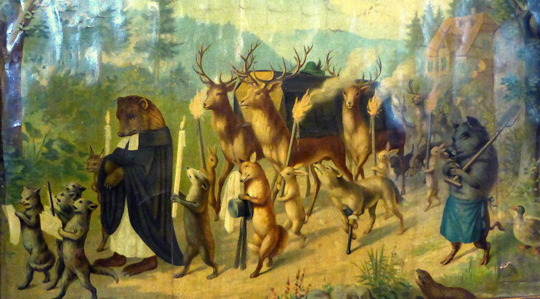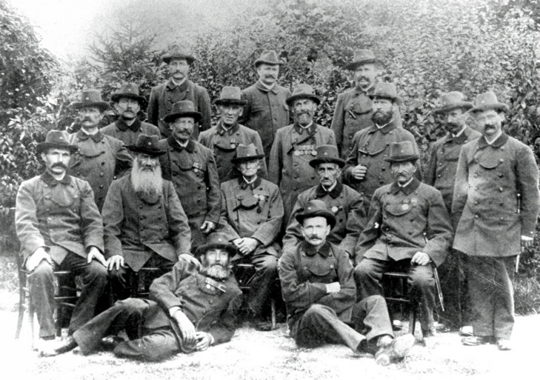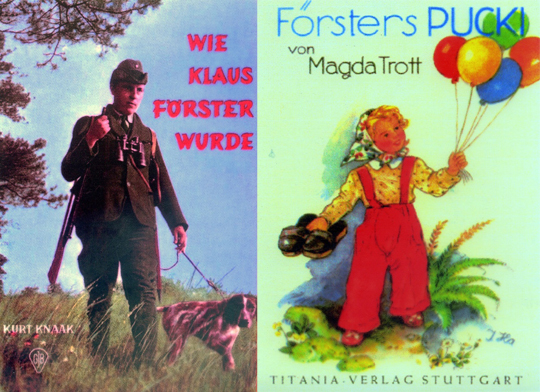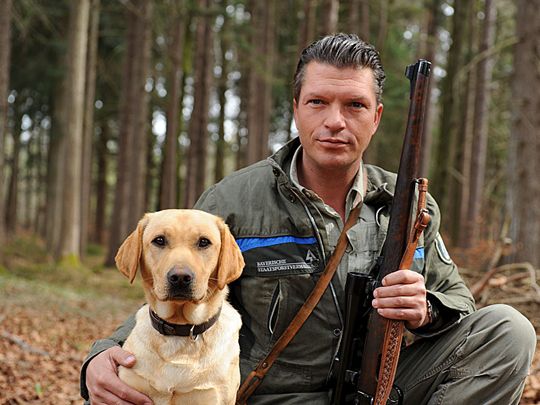With a Dog, a Hat, and a Gun
Freiburg, Aug 08, 2017
The forest ranger has been the subject of myths and stories ever since the profession originated in the early Middle Ages. Uwe Eduard Schmidt, professor of woodland and forest history at the University of Freiburg, and his students investigated the image of the forest ranger in society. They organized a poster exhibition that reveals what discourses, power constellations, and economic conditions have influenced historical changes in the public perception of the forest ranger. This small selection of pictures shows how the protector of the forest has been seen as everything from a menacing power figure to a caring father.
 Carried to his grave by a wolf, a bear, and a fox: In the mid-19th century the forest ranger develops into a forest patrolman who ruthlessly defends the interests of the state. The people therefore identify with wildlife during hunting season and dream of escaping the menacing power figure. Photo: Museum Münstertal/Schwarzwald
Carried to his grave by a wolf, a bear, and a fox: In the mid-19th century the forest ranger develops into a forest patrolman who ruthlessly defends the interests of the state. The people therefore identify with wildlife during hunting season and dream of escaping the menacing power figure. Photo: Museum Münstertal/Schwarzwald
 In the course of the Wilhelmine Era, from around 1890, forest rangers begin to command more respect among the populace. Their social standing is indicated by their uniforms, such as those worn by the district forest rangers of Staufen and Münstertal in the Black Forest. They are a reflection of the forest management hierarchy. Photo: Museum Münstertal/Schwarzwald
In the course of the Wilhelmine Era, from around 1890, forest rangers begin to command more respect among the populace. Their social standing is indicated by their uniforms, such as those worn by the district forest rangers of Staufen and Münstertal in the Black Forest. They are a reflection of the forest management hierarchy. Photo: Museum Münstertal/Schwarzwald
 In the postwar era, the forest ranger comes to be regarded as a model citizen. He stands for justice, a love of nature, and an identification with one's homeland. In the 1950s and the 1960s, 29 percent of German men named forest ranger as their dream job. The phenomenon is even a topic of books for young adults during this time. Photo: W. Fischer Verlag/Titania Verlag
In the postwar era, the forest ranger comes to be regarded as a model citizen. He stands for justice, a love of nature, and an identification with one's homeland. In the 1950s and the 1960s, 29 percent of German men named forest ranger as their dream job. The phenomenon is even a topic of books for young adults during this time. Photo: W. Fischer Verlag/Titania Verlag
 Hero and caring father: The image of the forest ranger today is influenced greatly by the media, for instance by the family television series Forsthaus Falkenau and its protagonist Stefan Leitner. Publications like those of the forest ranger and author Peter Wohlleben also testify to the continued pubic interest in the profession. Photo: Elke Werner/ZDF
Hero and caring father: The image of the forest ranger today is influenced greatly by the media, for instance by the family television series Forsthaus Falkenau and its protagonist Stefan Leitner. Publications like those of the forest ranger and author Peter Wohlleben also testify to the continued pubic interest in the profession. Photo: Elke Werner/ZDF

